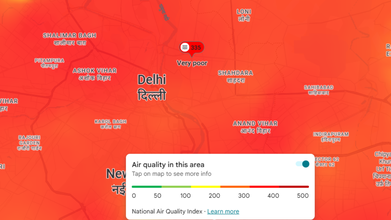- Health Conditions A-Z
- Health & Wellness
- Nutrition
- Fitness
- Health News
- Ayurveda
- Videos
- Medicine A-Z
- Parenting
- Web Stories
Delhi Air Pollution: 3 out of 4 households in Delhi-NCR Face Some Kind Of Pollution-Related Health Issues, Finds Survey

Credits: AQI/googlemaps.com
As per the India Meteorological Department (IMD), Delhi recorded a minimum temperature of 17.3 degree Celsius, which is 0.1 degrees above the season's average. While the maximum temperature is expected to be around 29 degree Celsius, there is a rain forecast too, with humidity level at 94% at 8.30 am on Monday. Despite this, the air pollution continues to persist, thanks to the thick layer of smog and persisting air pollution. The firecrackers continue to burst even days after Diwali, in fact, as notes the Indian Rice Exporters Federation, stubble burning incidents have declined by 68% in North India, this year. Despite all, Delhi has still recorded the most toxic post-Diwali air in five years, as per the Central Pollution Control Board (CPCB) data.
Also Read: Fact Check: Does Moon Really Affect Your Sleep And Mental Health? Here's What A Neurologist Says
Pollution Levels In Delhi
- As per the National Air Quality Index, as of 6.30 am, Anand Vihar recorded an AQI of 348, putting it under the 'very poor' category.
- Kashmere Gate recorded AQI of 299, under 'poor' category
- Rohini recorded an AQI of 346, under 'very poor' category
- Nangal Thakran, an area in Delhi recorded an AQI of 401, placing it under 'severe' category
- ITO recorded an AQI of 336, placing it under 'very poor' category
- Nazafgarh recorded an AQI of 307, placing it under 'very poor' category
- Azadpur recorded an AQI of 351, placing it under 'very poor' category
Health Impact Due to 'Very Poor' AQI
As per a recent survey, conducted by LocalCircles, based on the data from the CPCB, as reported by PTI, after Diwali, PM2.5 levels touched 488 micrograms per cubic metre. This is the highest in five years and over three times the pre-festival level of 156.6 micrograms per cubic metre.
The pollution levels rose on Diwali night on October 20 and next day in early morning.
The survey analyzed responses from residents across Delhi, Faridabad, Noida, Gurugram and Ghaziabad, to reveal that 42% of the households reported that one or more members had a sore throat or a persisting cough. The survey also notes that 25% of the family members suffered from conditions like burning eyes, headaches, and difficulty sleeping. 17% of them reported breathing difficulties or aggravated asthma.
As per the LocalCircles survey, 44% of households are trying to reduce their outdoor exposure and increase the intake of immunity-boosting foods and drinks to cope with poor air quality. However, as Health and Me reported previously, even the air inside the house is not safe to breathe.
Studies have found that air inside the city homes have 12 times more fungal spokes than the WHO safety limits. They can cause skin allergies, respiratory issues, and anxiety. As per a 2021 study by the Energy Policy Institute at the University of Chicago (EPIC India), PM 2.5 levels for low-income and high-income households in Delhi were high during the winters. The concentrations reported 23 and 29 times higher than the WHO safe limits, respectively. These findings also suggested that high-income households were 13 times more likely to own air purifiers than low-income households. Another study titled Microbial Indoor Air Quality Assessment and Health Correlations in Densely Populated Urban Areas of Delhi, India found that fungal and bacterial levels inside homes were several time higher than the World Health Organization (WHO)'s safe limits.
Read More: Think You’re Safe Indoors? Study Says Delhi’s Winter Pollution Follows You Home
How Can You Read AQI?
As per the CPCB, here's how the data on AQI can be interpreted
- 0-50 is considered ‘good’
- 51-100 is considered ‘satisfactory’
- 101-200 is considered ‘moderate’
- 201-300 is considered ‘poor’
- 301-400 is considered ‘very poor’
- 401-500 is considered ‘severe’
New Mpox Strain Detected in California Sparks Health Alert

Credits: Canva
More than two years after the mpox outbreak in the United States was officially declared over, a fresh cluster of cases in California has caught the attention of infectious disease experts.
The previous U.S. outbreak, which spread primarily among men who have sex with men, was declared over in early 2023, though sporadic cases have continued to appear. Now, health officials are worried after identifying three unrelated mpox cases in California linked to a more infectious and potentially more severe strain of the virus known as clade I mpox.
How This Strain Differs From the 2022 Outbreak
The mpox variant responsible for the 2022 outbreak belonged to clade II, a strain with a relatively low fatality rate. During that outbreak, over 32,000 infections were reported nationwide, resulting in 58 confirmed deaths—a mortality rate of about 0.2 percent.
Clade I mpox, by comparison, has been found to cause more serious illness and spread more easily. Both strains exist in parts of Central Africa, but clade I has historically shown higher transmissibility and mortality than clade II.
California Cases Raise Alarm Over Possible Community Spread
All three of the California patients infected with the clade I strain required hospitalization. According to the California Department of Public Health (CDPH), the pattern of infection suggests that, much like the 2022 outbreak, transmission is again occurring primarily within networks of men who have sex with men.
Dr. Joseph Cherabie, assistant professor of infectious diseases at Washington University in St. Louis and a board member of the HIV Medicine Association, said it was “only a matter of time” before clade I reached the U.S.
While a previous California case of clade I mpox was linked to travel in Africa, these recent infections have no known travel connections, a detail that worries experts. “That makes us a little bit uncomfortable as epidemiologists and as public health folks,” Cherabie said, adding that it signals local transmission that health authorities may not yet be fully detecting.
Transmission and Concerns About Undetected Cases
Mpox spreads mainly through direct skin-to-skin contact with someone who is infected, often through the painful rashes characteristic of the disease. Since the source of infection for these cases remains unclear, Cherabie believes there are likely more undetected cases circulating in the community.
When mpox first appeared in nonendemic countries in 2022, health agencies faced the challenge of having no treatments or vaccines made specifically for it. However, existing smallpox treatments were found to be effective against mpox, given their viral similarities.
Treatment and Vaccine Options
The smallpox vaccine Jynneos and the antiviral drug tecovirimat (Tpoxx) continue to be the leading tools for protection and treatment. Experts expect them to work against both clade I and clade II mpox.Jynneos requires two doses for complete protection, while Tpoxx can be given either intravenously or orally, depending on the severity of symptoms.
Texas Sues Tylenol Makers After Trump Links Painkiller To Autism — All You Need to Know

Credits: Canva
Texas sues tylenol: Texas Attorney General Ken Paxton announced on October 28 that he has filed a lawsuit against the makers of Tylenol, accusing them of failing to warn consumers about possible risks of using the drug during pregnancy. According to USA Today, the lawsuit targets Johnson & Johnson and its spin-off company Kenvue, alleging they concealed information about Tylenol’s potential links to autism and attention deficit hyperactivity disorder (ADHD), violating state consumer protection laws.
“These corporations lied for decades, knowingly endangering millions to fill their own pockets,” Paxton said in a statement. “When they saw accountability coming, Johnson & Johnson tried to dodge responsibility by offloading their liability to another company. By holding Big Pharma accountable for poisoning our people, we will help Make America Healthy Again.”
This marks the first lawsuit by a state government since President Donald Trump recently claimed that using Tylenol during pregnancy may raise the risk of autism — a claim that has limited scientific support.
Tylenol: Why Is Texas Suing Tylenol Makers?
Texas’s lawsuit, the first of its kind from any state, follows remarks made last month by President Trump and Health and Human Services Secretary Robert F. Kennedy Jr., who jointly issued new guidance discouraging pregnant women from using acetaminophen, the active ingredient in Tylenol. They cited it as a possible factor behind autism, sparking widespread concern and confusion among expecting mothers and healthcare experts alike.
The research surrounding Tylenol’s use in pregnancy remains unsettled. While a few studies have suggested a possible link between prenatal exposure and autism, many others have found no such connection. Major medical organizations have since pushed back against Trump and Kennedy’s statements, warning that the claims could spread unnecessary fear and misinformation.
This lawsuit is the first to formally adopt Trump’s theory that acetaminophen use in pregnancy might cause developmental disorders in children. The issue has long circulated among Kennedy’s followers, but Trump’s public comments brought it into mainstream discussion.
Texas Sues Tylenol: Tylenol Maker Fights Autism Warning Label
Kenvue has strongly defended Tylenol’s safety and dismissed Trump’s allegations, calling them misleading. Johnson & Johnson has also maintained that it has always acted responsibly in its product labeling, warning users only about the proven risk of liver damage from overuse.
In an official response, Kenvue stated that it was “deeply concerned by the spread of misinformation about the safety of acetaminophen and how it may affect women and children.” The company emphasized that acetaminophen remains “the safest pain relief option for pregnant women when needed throughout pregnancy.” Without it, they argued, women could face dangerous choices, either enduring untreated pain and fever, which may harm both mother and baby, or turning to more hazardous alternatives.
Over the past few years, hundreds of lawsuits have been filed nationwide by parents who believe their children developed autism or ADHD after prenatal Tylenol exposure. The largest group of such cases, consolidated in federal court in New York, was dismissed earlier this year due to insufficient scientific evidence. Plaintiffs have appealed the ruling, with an appellate hearing scheduled for November 17.
Texas Sues Tylenol: Is Acetaminophen Linked to Neurodevelopmental Disorders?
According to The New York Times, scientists have explored possible links between acetaminophen use during pregnancy and developmental disorders for years, but the research remains inconclusive.
Medical associations have rejected the Trump administration’s recent warning, reiterating that Tylenol is still considered the safest pain reliever for pregnant women. They warn that avoiding it altogether could be dangerous, as untreated high fevers and severe pain can pose serious health risks to both the mother and the unborn child.
Is The White House Hiding Truth About President Donald Trump’s Health?

Credits: Canva
President Donald Trump confirmed on Monday that he recently underwent an MRI at the Walter Reed National Military Medical Center but chose not to explain the reason behind it. The statement marks the first time Trump, 79, has spoken about his second medical visit this year.
The October 10 appointment, described by the White House as a standard yearly exam, has stirred speculation since it came just six months after his last comprehensive physical. “I did. I got an MRI. It was perfect,” Trump told reporters on his flight to Tokyo. When asked for more information, he declined to say more, saying journalists should “ask the doctors.” This has left many wondering if there is more to the story behind his current health condition.
Is The White House Hiding The Truth About Donald Trump’s Health?
The White House has declined to clarify when Trump last took a cognitive test, as his most recent medical summary does not mention one. Officials have also refused to provide any additional information about the MRI that Trump said he underwent earlier this month. His admission has renewed speculation about the 79-year-old president’s health.
While Trump maintains that he is in “excellent shape,” the timing and secrecy surrounding the MRI have raised eyebrows. MRI scans are often used to detect issues such as strokes, brain abnormalities, or tumors. “I got an MRI. It was perfect,” Trump told reporters aboard Air Force One, but no further explanation has been provided.
White House Report Did Not Mention Trump’s MRI
Despite Trump’s assurance that his doctors had released a “very conclusive” report, the official White House summary did not specify why he made a second visit to Walter Reed within the same year. Traditionally, presidents undergo one full medical examination annually.
According to CNN, White House physician Dr. Sean Barbabella’s report only noted that Trump had “advanced imaging,” a term that could refer to CT scans or other procedures. There was no mention of an MRI or any details about its purpose or findings.
Another missing detail was any reference to a cognitive assessment, which had been included in Trump’s first examination earlier this year. Following his April check-up, Dr. Barbabella’s report had spanned three pages, covering Trump’s lab work, prescribed medication, vital signs, and overall physical condition.
Donald Trump’s Medical Tests
During the April examination, Trump’s doctor confirmed that the president had taken the Montreal Cognitive Assessment (MoCA), a 30-point test that screens for memory and attention issues. The report at the time noted, “A comprehensive neurological exam revealed no abnormalities in mental status, cranial nerves, motor and sensory function, reflexes, gait, or balance.” It added that Trump scored a perfect 30 out of 30 on the MoCA, showing no signs of cognitive decline.
By contrast, Trump’s latest medical update, released after his October visit, was a brief five-paragraph note with no mention of any cognitive evaluation. When reporters asked if the president had taken one, the White House did not respond.
Trump did, however, bring up cognitive tests during a speech on Monday, mocking Democratic congresswomen Alexandria Ocasio-Cortez and Jasmine Crockett as “low IQ” individuals who “wouldn’t do well” on such exams. Yet he stopped short of revealing when he last took the test or what his latest score might have been.
So, Is the White House Really Hiding the Truth About President Donald Trump’s Health?
Trump’s second visit to Walter Reed in six months, along with visible bruising on his hands and swelling in his ankles, has added to speculation about his condition. His acknowledgment of an MRI, which is absent from the official White House report has only intensified public curiosity. The lack of transparency surrounding the test and not mentioning details in the official statement have led many to question whether the White House is concealing information about the president’s health.
© 2024 Bennett, Coleman & Company Limited

